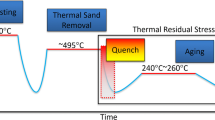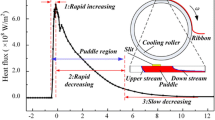Abstract
At the end of the hot rolling process, quenching is deployed for obtaining the desired microstructure and mechanical properties. During the quenching of aluminium plates, it is essential to optimize the process parameters such as the plate speed and cooling intensity for surpassing the C-curve. In this study, 1-D steady-state analytical model has been developed with the constant heat transfer boundary condition. The Eulerian computational domain contains the precooling and water cooling regions. Temperature drop starts in the precooling region itself due to back diffusion of heat, which originates from the water cooling region. Based on the analytical solution, the effect of plate speed and heat transfer coefficient on the cooling time has been investigated with the three non-dimensional parameters such as Peclect, Biot, and Fourier numbers. Typically, for the 2xxx (Al–Cu) alloys, every material point in the plate has to reach 350 °C within 0.2 s, which surpasses the nose of the C-curve where the phase transformation (CuAl2) severity can be reduced. This sets the limit for the maximum Fourier number and while keeping Peclect number as the independent variable, the minimum required water cooling in terms of Biot number is identified. The presented analytical solution provide the guidelines for selecting the appropriate combinations of plate speed and heat transfer coefficient for the quenching of continuously moving hot rolled plates. The results indicate that the nose of the C-curve can be surpassed easily by increasing the plate speed instead of reducing which contradicts the common notion.






Similar content being viewed by others
Abbreviations
- a :
-
Function defined in Eq. (8)
- Bi :
-
Biot number
- C :
-
Specific heat capacity (kJ kg−1 K−1)
- Fo :
-
Fourier number
- f 1 :
-
Fixed non-dimensional temperature (99% of initial temperature)
- f 2 :
-
Required non-dimensional temperature (C-Curve nose temperature)
- h :
-
Heat transfer coefficient (HTC) (W m−2 K−1)
- k :
-
Thermal conductivity (W m−1 K−1)
- Pe :
-
Peclect number
- s :
-
Thickness of the plate (mm)
- T :
-
Wall temperature (°C)
- T i :
-
Initial temperature of the plate (°C)
- T ∞ :
-
Ambient temperature (°C)
- t :
-
Time (s)
- u :
-
Speed of the plate (m min−1)
- X :
-
Non-dimensional length coordinate
- α :
-
Thermal diffusivity (m2 s−1)
- θ :
-
Non-dimensional temperature
- θ 0 :
-
Non-dimensional temperature at the interface of water cooling
References
Rivallin J, Viannay S. General principles of controlled water cooling for metallurgical on-line hot rolling processes: forced flow and sprayed surfaces with film boiling regime and rewetting phenomena. Int J Therm Sci. 2001;40:263–72.
Mascarenhas N, Mudawar I. Analytical and computational methodology for modeling spray quenching of solid alloy cylinders. Int J Heat Mass Transf. 2010;53:5871–83.
Ramezanzadeh H, Ramiar A, Yousefifard M, Ghasemian M. Numerical analysis of sinusoidal and step pulse velocity effects on an impinging jet quenching process. J Therm Anal Calorim. 2020;140:331–49. https://doi.org/10.1007/s10973-019-08828-y.
Eskin DG. Physical metallurgy of direct chill casting of aluminum alloys. Alloy: Phys Metall Direct Chill Cast Alum; 2008.
Vedani M, Angella G, Bassani P, Ripamonti D, Tuissi A. DSC analysis of strengthening precipitates in ultrafine Al-Mg-Si alloys. J Therm Anal Calorim. 2007;87:277–84.
Deiters TA, Mudawar I. Optimization of spray quenching for aluminum extrusion, forging, or continuous casting. J Heat Treat. 1989;7:9–18.
Ashby MF, Jones DRH. Engineering Materials 2: An Introduction to Microstructures, Processing and Design: Second Edition. Eng. Mater. 2 An Introd. to Microstruct. Process. Des. Second Ed. Elsevier/Butterworth-Heinemann; 2013.
Robson JD. Microstructural evolution in aluminium alloy 7050 during processing. Mater Sci Eng A. 2004;382:112–21.
Arslan H, Dogan A, Dogan T. An analytical approach for thermodynamic properties of the six-component systems Ni-Cr-Co-Al-Mo-Ti and their subsystems. Phys Met Metallogr. 2013;114:1053–60.
Arslan H, Doǧan A. Prediction of thermodynamic properties associated with six component alloys, Pb-free quaternary and ternary alloys. J Fac Eng Archit Gazi Univ. 2019;34:597–608.
Król M, Tański T, Snopiński P, Tomiczek B. Structure and properties of aluminium–magnesium casting alloys after heat treatment. J Therm Anal Calorim. 2017;127:299–308.
Chen SJ, Kothari J, Tseng AA. Cooling of a moving plate with an impinging circular water jet. Exp Therm Fluid Sci. 1991;4:343–53.
Mozumder AK, Monde M, Woodfield PL, Islam MA. Maximum heat flux in relation to quenching of a high temperature surface with liquid jet impingement. Int J Heat Mass Transf. 2006;49:2877–88.
Gradeck M, Kouachi A, Borean JL, Gardin P, Lebouché M. Heat transfer from a hot moving cylinder impinged by a planar subcooled water jet. Int J Heat Mass Transf. 2011;54:5527–39.
Fujimoto H, Shiramasa Y, Morisawa K, Hama T, Takuda H. Heat transfer characteristics of a pipe-laminar jet impinging on a moving hot solid. ISIJ Int. 2015;55:1994–2001.
Agrawal C, Kumar R, Gupta A, Chatterjee B. Determination of rewetting velocity during jet impingement cooling of hot vertical rod. J Therm Anal Calorim. 2016;123:861–71.
Yamanouchi A. Effect of core spray cooling in transient state after loss of coolant accident. J Nucl Sci Technol. 1968;5:547–58 (cited 2020 Apr 1).
Bonakdar H, McAssey E V. Method for determining rewetting velocity under generalized boiling conditions. Am Soc Mech Eng [Internet]. 1980. Available from: https://www.sciencedirect.com/science/article/pii/0029549381901783.
Sahu SK, Das PK, Bhattacharyya S. A comprehensive analysis of conduction-controlled rewetting by the Heat Balance Integral Method. Int J Heat Mass Transf. 2006;49:4978–86.
Kulkarni GA, Nallathambi AK, Specht E. Eulerian steady state solution of boiling curve for impinging water jet on moving hot metal plate. Heat Mass Transf und Stoffuebertragung. 2019;55:1819–28.
Sahu SK, Das PK, Bhattacharyya S. Rewetting analysis of hot vertical surfaces with precursory cooling by the heat balance integral method. J Heat Transfer. 2008;130:1–5.
Sahu SK, Das PK, Bhattacharyya S. An experimental investigation on the quenching of a hot vertical heater by water injection at high flow rate. Nucl Eng Des. 2010;240:1558–68. https://doi.org/10.1016/j.nucengdes.2010.02.028.
Thompson TS. An analysis of the wet-side heat-transfer coefficient during rewetting of a hot dry patch. Nucl Eng Des. 1972;22:212–24.
Agrawal MK, Sahu SK. Analysis of conduction-controlled rewetting of a hot surface by variational method. Heat Mass Transf und Stoffuebertragung. 2013;49:963–71.
Ruan Y. Steady-state thermomechanical analysis of continuously quenched materials. J Therm Stress. 1996;19:395–416.
Nallathambi AK, Specht E. Estimation of heat flux in array of jets quenching using experimental and inverse finite element method. J Mater Process Technol. 2009;209:5325–32.
Jaluria Y, Singh AP. Temperature distribution in a moving material subjected to surface energy transfer. Comput Methods Appl Mech Eng. 1983;41:145–57.
Sengupta J, Thomas BG, Wells MA. The use of water cooling during the continuous casting of steel and aluminum alloys. Metall Mater Trans A Phys Metall Mater Sci. 2005;36:187–204.
Author information
Authors and Affiliations
Corresponding author
Additional information
Publisher's Note
Springer Nature remains neutral with regard to jurisdictional claims in published maps and institutional affiliations.
Rights and permissions
About this article
Cite this article
Palanisamy, S., Nallathambi, A.K. & Specht, E. Analytical solution for quenching of hot rolled aluminium plates without passing through C-curve. J Therm Anal Calorim 141, 2665–2671 (2020). https://doi.org/10.1007/s10973-020-09874-7
Received:
Accepted:
Published:
Issue Date:
DOI: https://doi.org/10.1007/s10973-020-09874-7




